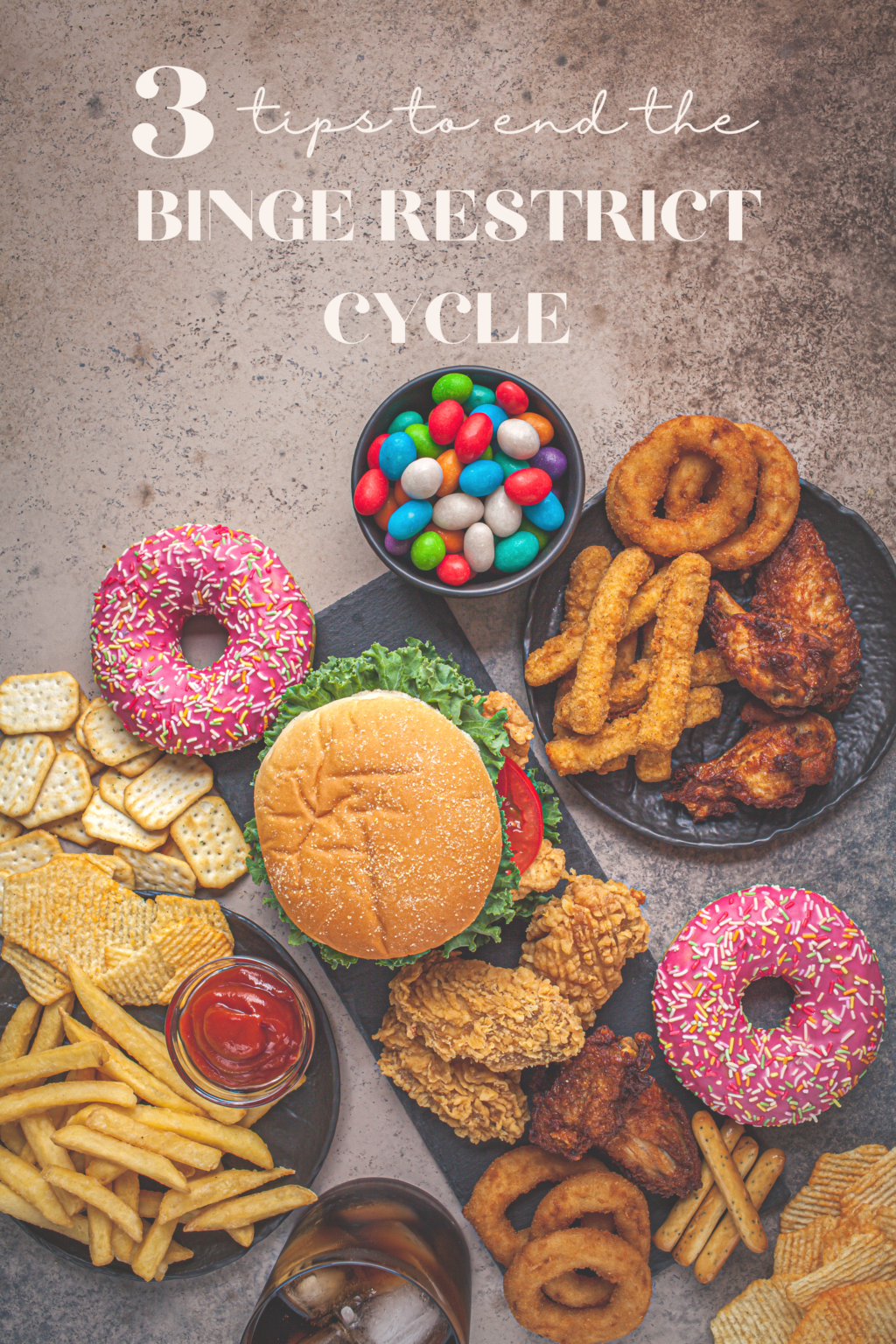Bingeing can be a distressing experience and it makes sense why we would want to “fix” it by compensating the next day with restriction. However, the “solution” may actually be perpetuating the problem. Read on to find out what the binge-restrict cycle is, what the 5 stages of the cycle looks like, how bingeing and restricting impacts us, and 3 tips to break the cycle for good from a registered dietitian.

If you’ve ever felt like a failure after a binge, you’re not alone. As registered dietitians, we’ve worked with a countless number of clients who carry this exact same belief. Diet culture leads us to believe that there is an inherent defect in us if we’re not able to stick to the diet. That we are somehow broken, lacking will power, and completely void of self control. Some might even chalk it up to being addicted to food. However, what many people don’t realize is that diets don’t work and it’s deprivation and restriction that are what actually drives bingeing. Today on the blog, guest author and intuitive eating dietitian, Ally Choo, takes us on a deep dive into what the binge-restrict cycle is, what the 5 stages of the cycle looks like, the impacts of binge eating and restriction, and 5 tips to break the cycle for good.
In this article you will learn:
- What is the Binge-Restrict Cycle
- The 5 Stages of the Binge-Restrict Cycle
- The Impacts of Bingeing and Restricting
- 3 Tips to Break the Cycle
Off the top, we often hear these two questions:
What many people don’t know is that dieting and restricting may actually be causing your urges to binge. Read more about that here.
When you binge eat, your “caveman brain” kicks in and you eat impulsively, without control regardless of your physical fullness. Read more about that here.
What is the Binge-Restrict Cycle?
The binge-restrict cycle can be described as the pattern of restricting (whether it’s starting a diet, counting calories to hold yourself accountable, or ‘watching what you eat’), which ultimately leads to bingeing or overeating. There are 5 main stages of the binge-restrict cycle.
Stage 1: Feeling shame, guilt, or out of control
According to shame researcher, Brene Brown, shame can be defined as “an intensely painful feeling or experience of believing that we are flawed and therefore unworthy of love and belonging.” Simply put, shame is believing that there is something wrong with you. Shame can be triggered by a number of things, including believing your body is wrong and needs to be smaller, having someone negatively comment on your body or what you are eating, comparing yourself to another person and feeling inferior, or believing you have no self control after a binge. Guilt, on the other hand, is believing that you did something wrong. This could be triggered by bingeing or eating an ‘off-limits’ food. Both guilt and shame can lead to feeling out of control, which can trigger you to enter the next stage of the cycle.
Stage 2: Restriction
In order to “fix” the problem (aka your body) and regain control, you decide to start a diet that you truly believe you will be able to stick to. You may start to restrict physically, decreasing portions, skipping meals, and cutting out certain food groups. There may also be an element of mental restriction, which involves categorizing foods as ‘good’ or ‘bad’ and allowing yourself to eat the ‘bad’ foods only if you compensate for them somehow.
Depending on how many diets you’ve tried, this stage might last for weeks, months, to even years. During this phase, you might be getting a lot of praise from others and feeling really successful at your ability to control yourself.

Stage 3: Deprivation
This is what we describe as ‘hitting the wall,’ physically, mentally, and emotionally. You notice that restriction no longer feels good, and that you can’t stop thinking about food. You’re noticing that you’re more preoccupied with food, recipes, food accounts on social media, and cooking shows. You might even feel obsessed with food. You might be noticing that you’re feeling more anxious or withdrawn, and you’re now refraining from going to social gatherings or events that have food around for fear of losing control.
Stage 4: Intense cravings and overwhelming urges to eat
The cravings and intrusive thoughts are starting to get louder. You’re finding it harder to focus on tasks at work, school, or be present in conversations. You start to intensely crave foods you’ve deemed “off limits” or “forbidden,” which are often cravings for carbs and other fast energy foods. You might even notice insatiable hunger and an inability to feel satiated.
Stage 5: Binge / Overeat
Finally, the restriction and intense cravings become too much and you ‘give in’. This is typically where the ‘caveman brain’ kicks in and you’re ripping open the cupboards and eating everything in sight. You have fully disconnected from what tastes good, feels good, and is satisfying, and are eating impulsively, regardless of your physical fullness. You truly believe that this is the one and only time you will allow yourself to eat these ‘forbidden’ foods, so you go all out and fall into the ‘last supper mentality’ as you tell yourself that you’ll get ‘back on track’ tomorrow.
After a binge, you feel defeated and ashamed with yourself. And then the cycle continues.
You might believe that you have a character flaw and that you’re just not strong enough to stop, but we’re here to tell you that that is not the case.
Restriction drives bingeing. Plain and simple. Here’s why:
When you continuously ignore your hunger and/or skip meals, the hunger hormone ghrelin is continuously being produced, which contributes to a roaring hunger. When you get too hungry, the ‘caveman brain’ comes in full force, and causes you to eat faster and choose richer foods. Additionally, dieting acts as a stressor on the body. When you are experiencing chronic levels of stress about your body or food choices, hormones like cortisol and insulin increase, which signal the body to store fat and disrupts muscle building. Lastly, restriction causes our brains to obsess about food as this is a biological mechanism to ensure our survival. When you finally ‘give in’ you’re now more susceptible to the all or nothing mentality, which can further push you to binge.
All of this sets you up for bingeing, cravings, guilt, and shame.
Ready to Transform Your Relationship with Food?
Explore not just what you eat but why you eat, how you feel when you eat and any patterns that affect how you feel or impact any choices you make and start your journey to food freedom today!
The Impacts of Bingeing and Restricting
So now that we know what the binge-restrict cycle is, why is it important to break the cycle?
Physiological impacts of restriction
Your cells cannot tell the difference between a self imposed diet or a famine. Given this, the body will adapt to conserve energy when it perceives that food is scarce. Over time, the body will increase hunger hormones, decrease fullness hormones, slow its metabolism, lower its heart rate, decrease its body temperature, slow digestion, and down-regulate any non-vital systems (including your reproductive system, hair, skin, and nails). This, in turn, can lead to various complications, including:
- Constipation and discomfort due to loss of muscle tissue along the digestive tract
- Loss of muscle mass
- Decreased emotional regulation
- Fatigue and poor concentration
- Decreased immune system
- Reduced fertility
- Increased risk of cardiac failure
Physiological impacts of binge eating
Bingeing not only leads to stomach pain, but can also lead to stomach distension, which can lead to delayed stomach emptying and an increased intensity of fullness after eating. It can also result in an overstimulation of the pancreas which can lead to low blood sugars. This might cause symptoms of sweating, fatigue, dizziness, or headaches after a binge. Consistently overriding your fullness cues can further disconnect you from your body.
3 Tips to Break the Cycle
If you’re ready to break the binge-restrict cycle and learn how to stop feeling guilty after eating, here are 3 tips to get you started:
1. Address shame with self Compassion
Through the amazing work of Dr. Kristin Neff, studies show that self-compassion can help to address the judgement of shame. It has also been shown to be associated with increased intrinsic motivation and improved health behaviours.
Dr. Kristin Neff describes self compassion in 3 parts:
1 – Self-kindness vs Self-judgement
Instead of criticizing ourselves for the mistakes we have made or our perceived failings, we instead greet ourselves with warmth and understanding. We recognize that being imperfect and facing difficulties in life is inevitable and part of being human.
2 – Common humanity vs. Isolation
Involves recognizing that suffering and feeling inadequate is “part of the shared human experience” and that we are not alone in our suffering
3 – Mindfulness vs. Over-identification
Mindfulness is, simply put, awareness without judgement. This involves taking a pause and holding space for our pain, thoughts, and emotions without trying to suppress or deny them. It may be helpful to work with a trusted intuitive eating dietitian or counsellor to help process through some of the themes that may come up.

2. Address restriction with consistent, adequate, nutrition and unconditional permission to eat
Address physical restriction first to stave off intense cravings and the urgency to eat. Eating every 2-3 hours can help with maintaining stable blood sugars and giving your body the nutrition it needs to feel safe and secure (vs. threatened by a famine). If you’re not sure where to start, here are 10 healthy eating habits from a registered dietitian and 15+ well balanced meal ideas.
Addressing mental restriction can be just as important (if not more!) than physical restriction. Mental restriction arises from believing that certain foods are ‘good’ and certain foods are ‘bad.’
When we impose moral value on foods, it’s our human nature to, in turn, place moral judgements on ourselves. If we feel that we’ve broken the rules by eating a ‘bad’ food, we’re more likely to feel intense guilt/shame, which often leads to the all or nothing thinking or the ‘last supper mentality.’ Having these rigid rules to follow or a list of ‘forbidden’ foods sets us up to binge. Instead, we need to even the playing field and understand that all foods are morally equal, regardless of what diet culture tells us. By giving ourselves unconditional permission to eat all foods and removing the food rules and restrictions, we can truly become better connected and in touch with what would feel mentally and physically best.
3. Cultivate self awareness around your eating habits
If you’ve tried to make changes in the past but your efforts seemed short lived, don’t worry, we got you. This can often happen when we don’t truly know what our patterns, habits, and triggers are. In order to make lasting changes, we need to build self awareness not just around what we eat but also why we eat. In our Make Food Feel Good Program and with our 1:1 clients, we often recommend our clients keep a mindful food journal to help them better understand their habits and their motivations behind their choices. Having this awareness is key since once we see it, we can’t unsee it. This data allows us to discover Why am I eating? Understanding the 3 types of hunger. It can also help you learn how to have a healthy relationship with food and what healthy eating means to you.
Ready to Transform Your Relationship with Food?
Explore not just what you eat but why you eat, how you feel when you eat and any patterns that affect how you feel or impact any choices you make and start your journey to food freedom today!
Now over to you
- Did anything about the binge-restrict cycle surprise you?
- Any questions we missed about the binge-restrict cycle?
Share with us in the comments below or take a screenshot and share it with us over on Instagram! And if you found this post helpful, pass it along to a friend or family member who could benefit from it too!
Looking for more support?
Looking for support to end the diet cycle, trust your body and learn the nutrition that feels amazing for YOU? Learn more about my Make Food Feel Good Program here where hundreds of women have found lasting success through my proven framework and step-by-step guided support. Let’s Chat!









Leave a Comment & Rate this Recipe